Kirby Larson's Blog, page 24
December 13, 2013
Friend Friday
It's a thrill to introduce you to Genny Heikka, a blogger, speaker and friend from Northern California. Most important, however, is that Genny is a writer and today we get to share in the joy of her new books!

When I opened the package I got in the mail a couple weeks ago and saw my latest children's books, I was excited.
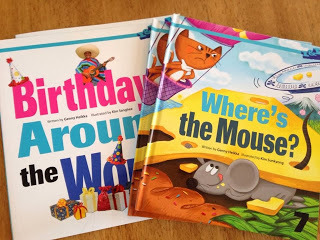
I wrote the books in 2011 and was seeing them for the first time, two years later.
Even though my kids weren't jumping up and down shouting, "Mommy! Your books!" like they used to (they're 12 and 14 now and barely noticed when I got the package), I still had that feeling of joy that comes from seeing your ideas and hard work turn into something you can actually touch and feel.
Something you can read.
To be honest, as I sat there leafing through the pages, I felt like I was reading my own words for the first time. Of course I remembered the stories, but because I'd written these books two years ago, reading the words again (and seeing the illustrations for the first time) was a fun process of discovery.
I wrote both of these picture books--Where's the Mouse? and Birthdays Around the World--for Tun Tun, a publisher in Korea that creates books to help children learn English as a second language. Both books were work-for-hire assignments and were rewarding projects to work on. Where's the Mouse? was written not only to help Korean children learn to speak English, but also to help them with geography. In the story, the main character (a mouse) travels to different countries eating cheese and avoiding capture, only to end up in a bakery, eating cheesecake.
Birthdays Around the World started as a whole different idea years ago that I had for a picture book. I wanted to call it Hugs Around the World and wrote the story to share different ways people greet each other in different countries. I remember bringing it to my critique group, getting feedback on it, making revisions, and then having sudden inspiration to totally change the story so that it showed birthdays around the world, instead of hugs. I was excited about the idea, and my critique group was too, but after rewriting it, I didn't do much with it, and it sat in my files. Then, when I was working with Tuntun on Where's the Mouse?, I submitted my idea for Birthdays Around the World since that tied into geography. They liked it, we worked together to refine the story to meet their requirements, and the end result is this second book.
I love how when you write, nothing is waste!
I typically don't hold on to things for a long time (I'm one of those people who likes to clean out closets and drawers!), but I save every story I've written, and every revision. Because you never know when one of your stories may end up becoming a book, or when you might be able to use an old idea in a fresh way.
Thank you, Genny -- this is a good reminder that nothing we write is ever wasted. And that some stories find homes we'd never imagined possible! Congratulations on your new books.

When I opened the package I got in the mail a couple weeks ago and saw my latest children's books, I was excited.

I wrote the books in 2011 and was seeing them for the first time, two years later.
Even though my kids weren't jumping up and down shouting, "Mommy! Your books!" like they used to (they're 12 and 14 now and barely noticed when I got the package), I still had that feeling of joy that comes from seeing your ideas and hard work turn into something you can actually touch and feel.
Something you can read.
To be honest, as I sat there leafing through the pages, I felt like I was reading my own words for the first time. Of course I remembered the stories, but because I'd written these books two years ago, reading the words again (and seeing the illustrations for the first time) was a fun process of discovery.
I wrote both of these picture books--Where's the Mouse? and Birthdays Around the World--for Tun Tun, a publisher in Korea that creates books to help children learn English as a second language. Both books were work-for-hire assignments and were rewarding projects to work on. Where's the Mouse? was written not only to help Korean children learn to speak English, but also to help them with geography. In the story, the main character (a mouse) travels to different countries eating cheese and avoiding capture, only to end up in a bakery, eating cheesecake.
Birthdays Around the World started as a whole different idea years ago that I had for a picture book. I wanted to call it Hugs Around the World and wrote the story to share different ways people greet each other in different countries. I remember bringing it to my critique group, getting feedback on it, making revisions, and then having sudden inspiration to totally change the story so that it showed birthdays around the world, instead of hugs. I was excited about the idea, and my critique group was too, but after rewriting it, I didn't do much with it, and it sat in my files. Then, when I was working with Tuntun on Where's the Mouse?, I submitted my idea for Birthdays Around the World since that tied into geography. They liked it, we worked together to refine the story to meet their requirements, and the end result is this second book.
I love how when you write, nothing is waste!
I typically don't hold on to things for a long time (I'm one of those people who likes to clean out closets and drawers!), but I save every story I've written, and every revision. Because you never know when one of your stories may end up becoming a book, or when you might be able to use an old idea in a fresh way.
Thank you, Genny -- this is a good reminder that nothing we write is ever wasted. And that some stories find homes we'd never imagined possible! Congratulations on your new books.
Published on December 13, 2013 05:30
December 12, 2013
From the Office of the Future of Reading
Please join me in welcoming today's guest blogger, Gregory Taylor. Gregory is a school librarian and former English teacher at Hillside Junior High School in Boise, Idaho. He's loves Disneyland, Shakespeare plays, and talking to kids (and grown-ups) about YA Lit. You can follow Gregory on Twitter @bookhouseboy and on his YouTube channel, The Bookhouse.

Let me lure you into the library…
I love being a junior high librarian. Our library is filled to capacity – in the morning before school, during our mid-morning break, and every lunch period -- with kids reading, typing, playing games, finishing homework, and just hanging out.
But for every kid I see weekly, or even daily, I know there are at least a couple others who never walk through our door unless a teacher has scheduled their class for research or some other library activity. I want those kids in the library, too. I want them ALL!
I know if I can get a student to voluntarily walk in the door – for any reason – it will create a traffic pattern that will happen more easily the next time. We “trick” kids into visiting the library in all sorts of wily ways, hoping that once they walk in, we can convince them to stay… and come back again.
The Fun Room:
Our library has a small side room that used to contain dusty, seldom-used teacher materials and a huge, awkward table. We transformed the room into a student-friendly space that houses our audio books, graphic novels, manga, Guinness books, DVDs, games, and how-to-draw books. It now has a smaller table (but still big enough for jigsaw puzzles, card games, and chess face-offs), and some comfy second-hand chairs and couches. We christened it The Fun Room. We now have kids who race in to occupy the Fun Room every day – before school, during mid-morning break, and at lunch.
Contests, Games, Activities:
One of our favorites is Guess-How-Many. We fill a large jar with seasonal candy and students fill out a slip to guess how many pieces are in the jar. We usually have the jar out for a week, and during those few days I see faces I rarely see in the library. It’s a chance for me to say hi, learn their names, invite them back.
We also have holiday-themed puzzles, coloring sheets, and scavenger hunts. At Christmas time we cut snowflakes at lunch. During Teen Read Week in the fall and Read Across America week in the spring we have dress-up days like Tie-Dye Tuesday, Cat-in-the-Hat day (wear a cool hat), or Freedom Friday (wear red, white, and blue). Kids can get a treat or a prize (like a bookmark or a piece of candy) for dressing up, but only if they come to the library to show us their outfit – and maybe get their picture taken!
World Wide Wednesdays:
Starting this year, we’ve been playing a YouTube video every Wednesday during the mid-morning break. We might show a song, or a science experiment, or a vlog post (and every once in a while we sneak in a book trailer or something about an author). This has pulled a completely different crowd into the library at Break, and because we don’t start the video right away, these new library users have a few minutes to hang out and see our regulars doing all the different things that go on in a thriving library. Break is our busiest time of the whole day, and now Wednesdays are busiest of all.
Special Events:
Sometimes it’s a Lit Lunch, where we advertise a title several weeks in advance and then host a pizza lunch and book discussion. We close the library during Lit Lunches; only the kids who read the book and sign up in advance get invitations.
Sometimes it’s a meeting of the Library League – our club for kids who love the library – and everyone is invited in for library news, give-aways, the unveiling of our newest book arrivals, and cookies!
And sometimes it’s an actual author appearance. Kenneth Oppel’s visit earlier this fall for an assembly and Lit Lunch was one of our most popular events ever.
These are just a few of our sneaky strategies for tempting teens into the library. Once we start brainstorming, it’s not hard to come up with new ideas that don’t require a ton of time or money. We know if we can get them in the door, they just might stick around. And keep coming back, all their lives.
Thank you Gregory for sharing such creative ways to lure, I mean, bring kids into the library.
Published on December 12, 2013 05:30
December 11, 2013
Wednesday Wisdom
Knowing what you want is the first step in getting it.
Dr. Louise Hart
Dr. Louise Hart
Published on December 11, 2013 05:30
December 10, 2013
From the Office of the Future of Reading
Please join me in welcoming today's guest blogger, Kimmie Vogt. For the past two years, Kimmie has had the great opportunity to be Wonder Woman Librarian for Hastings Middle School, Hastings, Nebraska. Before that, she was a science teacher for nine years in the same building. Her passion of working with this age group has been with her since she was in middle school (junior high then), because it can be really hard without someone who cares about you. Kimmie lives with her husband -- Spencer (also a middle school teacher), a Great Dane named Luna and two cats of opposite sizes, Bubba (21 lbs) and Gizmo (7 lbs). You can find Kimmie on Twitter or on her blog.
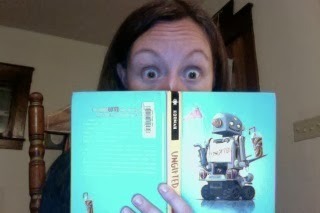
Connecting Kids to Books
How do you connect kids to books? You have to know the kids.
How?*Talk with them.*Like them.*Use their name.*Show them that you care.*Know what is going on in their world--talk about video games, movies, One Direction,Minecraft...whatever it takes.*Greet them with a “hello” when they walk through the library.*Bring books to them (in class) that you think they will like or ones they have requested.*Ask the question, “what book have you read lately that you really liked?” Based off what the kids say, you can help them find books that are similar or use Goodreads/Amazon/Google to help you find books to match.
Other things that seriously help.*Get out from behind your desk--be with them.*Read like your hair's on fire (thanks, Patti Digh) and tell the kids they need to as well.*Plan a library program that is kid friendly with a mixture of 21st century skills, book talks, promoting movies/books and etc.*Make comfy places available for reading in the library (pillows, bean bags, reading nooks, space for reading, patio for reading outside).
The lists above are the keys to my success for connecting kids with books.
When kids know you care; when kids trust you--that’s when they will keep coming back for more books.
Wow, Kimmie -- I sure wish you'd been my librarian in junior high! Thanks for your passion and wonderful insights.
Published on December 10, 2013 05:30
December 6, 2013
Friend Friday
Kristen Kittscher is a new friend; we met at Wordstock in Portland earlier this fall. I so enjoyed her presentation with Jeanne Birdsall, and when I learned that Kristen's first book was a mystery, I had to read it. So I did, on the train home from Portland. I so enjoyed The Wig in the Window that I asked Kristen if she'd write a post. And she cheerfully agreed. Without further ado, here's Kristen!
 Kristen Kittscher
Kristen Kittscher
When I was twenty, I worked in customer service at a Connecticut trucking company. Days passed in a blur of phone calls from irate customers wondering why their vitally important ball bearing shipment hadn’t arrived yet or when (insert stream of expletives) their 50 tons of artificial sweetener from Georgia would finally roll in. It was a job with very few highlights, other than chitchatting with the long-haul truckers about the sights they’d seen on the road: houses made of corn, giant balls of twine, the occasional UFO.
When one of those truckers—a kindly, fatherly type—told me about his weekends flying around in his WWII-era plane, my eyes must have lit up. “Want to come?” he asked. He pulled out a picture of a maroon plane that looked more like a remote controlled toy than an actual means of transportation.
“Yes,” I said. I’m not sure he’d even finished uttering the question.
Fly around in an ancient tiny tin can? With a burly stranger who claimed to be a licensed pilot, but who heretofore I’d only witnessed driving 18-wheelers?
“I’d love to,” I added. (Did I mention I was twenty?)
And fly we did. All summer, in fact. I’d eventually learn how to take off myself, pressing the rudder pedals to keep the plane straight as we taxied down the runway. We’d head to Martha’s Vineyard for lunch. We’d cruise to Manhattan at night, where we had to fly low to avoid commercial traffic. The Twin Towers glinted in the moonlight behind us as we circled close around the Statue of Liberty to get a good photo.
“Want to go to Philadelphia today?”“I always wanted to see the Liberty Bell.”“How about Portland?”“You bet.”
I never turned down an adventure.
Flash forward to a year later: a U.S. Air 737 drops out of the sky on a beautiful clear day outside of Pittsburgh, killing everyone aboard. Investigators have no idea why—and they won’t for four more years. The next flight I take finds me dripping sweat and gripping the seat rests. 15 years of flight fears follow. Hours spent watching flight attendants for signs of trouble. Jumping at every captain announcement. Counting the chimes over the intercom, wondering if it’s Morse code for “We’re going down!” I believe if I relax for one minute, that plane is going to plummet to earth. It’s my job to keep us all aloft. I just need to keep looking at that wing…
I’m exhausted after every flight. Fear sure is hard work. It’s hard work I’ll let go of, eventually. I’ll finally surrender to the overwhelming evidence that millions of flights successfully take off and land without Kristen Kittscher there to micromanage the process with her mind.
When I’m having a terrible writing day (or week…or month?), I think of that terrified flyer—and the senseless of all that hypervigilance. Sure, a little self-consciousness comes in handy during revision. But when drafting? You can’t worry about the fact that you’re in a tin can thousands of feet up. Or that your pilot is a little more used to driving eighteen-wheelers than navigating the skies. Or that a plane can drop out of the sky for no good reason.
“Want to come?” your story asks you. “Yes,” you must say. “I’d love to.”
And then your breath catches as you bank away from the Statue of Liberty and take in the brilliant Manhattan skyline stretched out before you…
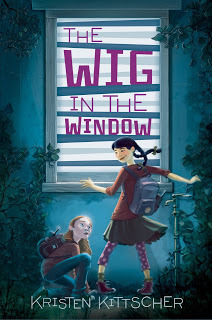
Watch the fabulous The Wig in the Window book trailer here. Follow Kristen on Twitter: @kkittscher
 Kristen Kittscher
Kristen KittscherWhen I was twenty, I worked in customer service at a Connecticut trucking company. Days passed in a blur of phone calls from irate customers wondering why their vitally important ball bearing shipment hadn’t arrived yet or when (insert stream of expletives) their 50 tons of artificial sweetener from Georgia would finally roll in. It was a job with very few highlights, other than chitchatting with the long-haul truckers about the sights they’d seen on the road: houses made of corn, giant balls of twine, the occasional UFO.
When one of those truckers—a kindly, fatherly type—told me about his weekends flying around in his WWII-era plane, my eyes must have lit up. “Want to come?” he asked. He pulled out a picture of a maroon plane that looked more like a remote controlled toy than an actual means of transportation.
“Yes,” I said. I’m not sure he’d even finished uttering the question.
Fly around in an ancient tiny tin can? With a burly stranger who claimed to be a licensed pilot, but who heretofore I’d only witnessed driving 18-wheelers?
“I’d love to,” I added. (Did I mention I was twenty?)
And fly we did. All summer, in fact. I’d eventually learn how to take off myself, pressing the rudder pedals to keep the plane straight as we taxied down the runway. We’d head to Martha’s Vineyard for lunch. We’d cruise to Manhattan at night, where we had to fly low to avoid commercial traffic. The Twin Towers glinted in the moonlight behind us as we circled close around the Statue of Liberty to get a good photo.
“Want to go to Philadelphia today?”“I always wanted to see the Liberty Bell.”“How about Portland?”“You bet.”
I never turned down an adventure.
Flash forward to a year later: a U.S. Air 737 drops out of the sky on a beautiful clear day outside of Pittsburgh, killing everyone aboard. Investigators have no idea why—and they won’t for four more years. The next flight I take finds me dripping sweat and gripping the seat rests. 15 years of flight fears follow. Hours spent watching flight attendants for signs of trouble. Jumping at every captain announcement. Counting the chimes over the intercom, wondering if it’s Morse code for “We’re going down!” I believe if I relax for one minute, that plane is going to plummet to earth. It’s my job to keep us all aloft. I just need to keep looking at that wing…
I’m exhausted after every flight. Fear sure is hard work. It’s hard work I’ll let go of, eventually. I’ll finally surrender to the overwhelming evidence that millions of flights successfully take off and land without Kristen Kittscher there to micromanage the process with her mind.
When I’m having a terrible writing day (or week…or month?), I think of that terrified flyer—and the senseless of all that hypervigilance. Sure, a little self-consciousness comes in handy during revision. But when drafting? You can’t worry about the fact that you’re in a tin can thousands of feet up. Or that your pilot is a little more used to driving eighteen-wheelers than navigating the skies. Or that a plane can drop out of the sky for no good reason.
“Want to come?” your story asks you. “Yes,” you must say. “I’d love to.”
And then your breath catches as you bank away from the Statue of Liberty and take in the brilliant Manhattan skyline stretched out before you…

Watch the fabulous The Wig in the Window book trailer here. Follow Kristen on Twitter: @kkittscher
Published on December 06, 2013 05:30
December 5, 2013
From the Office of the Future of Reading
Please help me welcome today's guest blogger, Deb Krygeris. Deb teaches sixth grade at Whittier School in Downers Grove, IL, all Blackhawks fans! E-mail her or follow her on Twitter.
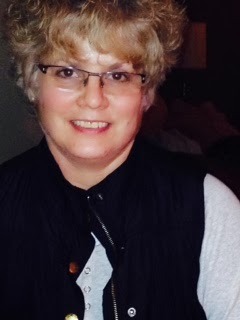 Deb Krygeris
Deb Krygeris
My Most Important Job…
When I left a successful career 7 years ago to become a teacher, I had no idea that my “hobby” would become my most valuable tool for success in the classroom. I’ve always been a reader...that’s just who I am, who I’ve always been, and frankly, my reading life becomes more important to me the older I get. But what I find truly amazing is that in teacher ed programs (at least mine and the one my daughter is currently enrolled in) they don’t tell you the key to hooking students on reading, to helping students become lifelong readers, is to share your reading life with them.
As I began teaching sixth grade, I observed how a good book transformed my students. An author study of Jerry Spinelli’s works: Crash, Loser, Stargirl, Maniac Magee, Milkweed, and finally, Knots In My Yo-Yo String generated such excitement. Hands were flying in the air as we read Knots and my students made connections from Jerry’s life to scenes or incidents in his books. It was a race to see who could find the most connections! Student engagement and enthusiasm was unprecedented.
Read aloud become the most important time of the day. I raced through books to satisfy my students’ desire to read the next in the series: Andrew Clements’ Things Not Seen, Things Hoped For, and Things That Are; Kenneth Opel’s Airborne, Skybreaker, and Starclimber; Laurie Halse Anderson’s Chains and Forge, and so many, many more. While interests and “right fit” novels changed every year with every new class, the enthusiasm and love for read aloud was consistent.
But, being a new teacher, I didn’t trust my instincts, I continued to try to teach the “required” curriculum using an anthology that was extremely challenging and useless for engaging readers. I was bored reading these stories, I couldn’t connect, but I didn’t take the hint. Instead, I tried to do it all-incorporate engaging, newly released novels and the required curriculum pieces. I felt crazed and can only imagine how my students’ felt!
Then along came Donalyn Miller’s The Book Whisperer. Finally an expert, experienced teacher verified what I knew in my heart: I needed to trust myself, my reading life, my book experiences, and share them with my students. I built my reading instruction around engaging, compelling novels, and watched my students take off. Students were writing and recording book reviews, conducting book talks, competing for books, begging me to purchase a book, and requesting time for independent reading - it was a teacher’s dream come true! Fast forward a few years and hundreds of novels later, and I know I’m building readers and my classroom’s reading culture is distinct and highly desired. Now as I read Donalyn Miller’s new Reading in the Wild and Ariel Sacks’ Whole Novels for the Whole Class, I have further affirmation that what I’m doing is the best thing for my students.

What do I see in my classroom now, seven years later? I hand out tissues to Allison, Grace, and Alyssa as they read Jo Knowles, See You At Harry’s, my summer read that I book talked and is now circulating quickly in the room. My two copies of Kate Messner’s Wake Up Missing, are “missing” somewhere among my kids and I’ll have to buy another if I want to read it soon! I had to beg Aidan to return House of Hades and promise to read it quickly over Thanksgiving break so Henry could have it when we return to school. Blake has already read 30 books this year and I’m challenged to find new recommendations for him. I’m begging Kelly to read Divergent because I need to talk about this series with someone I know will connect with it..
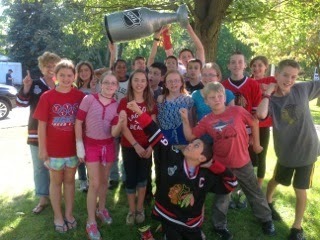
Seven years later, I’m also trying to spread the love of reading outside of my classroom. My school’s reading specialist and I developed a new district-wide reading competition, The Reading Games, (similar to Battle of the Books), to encourage reading quality books in our 3rd to 8th grade students. At last count, over 35 teams of 8 students are registered to compete in this inaugural event. Thankfully, we also have district administration that supports teacher initiatives like The Reading Games and encourages teachers to follow their instincts and “own” the curriculum. But, my most important job and frankly, the one I enjoy the most, is to continue to share my reading life with my students, to set that example, find the one book match to engage that reluctant reader, and maintain a distinctive, desirable reading culture in my classroom. Who could ask for a better job than this?
I totally agree, Deb! Thank you for sharing your experiences and for sharing your love of books!
Published on December 05, 2013 05:30
December 4, 2013
Wednesday Wisdom
A good book is the best of friends, the same today and for ever.
Martin F. Tupper
Martin F. Tupper
Published on December 04, 2013 05:30
December 3, 2013
From the Office of the Future of Reading
Please help me welcome today's guest blogger, Megan Ginther. Megan teaches 5th grade language arts and social studies in Lebanon, Ohio. She has taught 5th or 6th grade for 12 years. She loves reading, cooking, walking, traveling, and spending time with family and friends. When she’s not curled up reading with her four-year-old daughter, she’s found in various rooms of the house sneaking a few pages of the latest book in which her nose is buried. Megan contributes to Choice Literacy each month and blogs about her “Adventures in Learning” on her blog. She is also on Twitter.

Literacy Contracts--Engaging kids in reading and writing each month of the school year
When I first started teaching in 2002, a wonderful colleague introduced me to Reading Contracts. These contracts usually involved reading two books per month and completing some type of assessment after the reading was finished. The beauty of these contracts was that the books were chosen by the students and the contract was signed by the parents. Everyone was on the same page and there was the element of CHOICE in reading. The contracts were successful in not only getting students to read outside their comfort zone (often each month was devoted to a separate genre), but it got my sixth graders to read more than they had ever read in the past. Not only were they reading the two books on the contract, but they were reading more books on top of that. Reading begets more reading, afterall.
As the years have gone by, my reading contracts have evolved into literacy contracts. Because of the limited amount of time intermediate and middle school teachers have to teach Language Arts, I’ve adapted my contracts to provide the most bang for my buck. I’ve not only incorporated reading books (typically one book group book and one nonfiction book), but I’ve also incorporated writing about the reading the students are doing and technology. These contracts change each year, depending on the class I have. But one thing stays the same, the expectation for reading is high and my students beg for the next contract so they can once again be a part of a book group, sharing a common text with five or six other kids, and digging into the meat of reading and sharing in a reading community.
Over the course of this year so far, another colleague and I have been working on theme topics for our contracts. September was empathy, in which we focused on animal and human rights. We read aloud The One and Only Ivan and focused our nonfiction book on human rights. The book group book was realistic fiction that involved empathy. Students had to write a claim/evidence paragraph in which they made a claim about empathy and supported it with evidence from the text. In October, we centered our learning on the theme topic fear. What a perfect theme for October! We read another book group book, this time historical fiction, related to some type of fear. Upon completion of the novel, students wrote and acted out a skit of four major plot points of the book, in which they had to provide a summary and background about the time period. They loved it! The nonfiction book was self-selected about a fear the student had, followed by them making a claim about their particular fear and supporting it with evidence from the text. Finally, students found an infographic, video clip, or article that dealt with a fear. They presented to small groups. It was wonderful! This month our topic is family. We’re reading book group books that involve families, again realistic fiction, and students are reading memoirs. The culminating projects this month are creating a digital scrapbook of any “family” that is important to them and writing their own memoir.
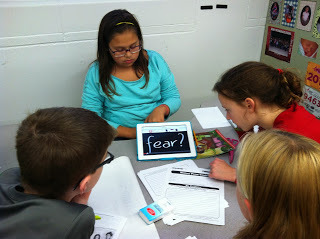
We’ll keep working our way through topics this school year and incorporating close reading, writing about reading, and presenting. The possibilities are endless and so easily catered to the group you have! It’s not only fun, but also rewarding to watch as students delve into each contract and work their way through it all month long. And, it guides my teaching. I know I’m hitting all of the standards because I focus my contracts around the reading and writing requirements of the Common Core.
My favorite phrase each year is, “When are we getting the next contract?”, followed by, “I didn’t know if I would like that book, but ended up loving it!” Contracts have not only helped my students read more, they’ve helped broaden their horizons in the reading world. You can’t ask for much more than that!
Check out Choice Literacy (in which my colleague Holly Mueller and I write a monthly article) and my blog, “Adventures in Learning” for more in-depth descriptions about literacy contracts. I think you’ll like what you see!
Thank you Megan for these great insights on how to make reading contracts work!
Published on December 03, 2013 05:30
November 29, 2013
Friend Friday
I am delighted to introduce my dear friend, Ann Whitford Paul, to you today. Ann and I go way back -- in fact, she knew me long before I was ever published. Her friendship has meant the world to me, and I am also very grateful for her critical eye when it comes to improving my manuscripts. Brew yourself a mug of hot chocolate and enjoy Ann's post!

Friends and family call me, “Crazy for Christmas.” They don’t mean it as a compliment.I start decorating for the holiday right after Thanksgiving. Nothing gives me more pleasure than spreading the red and green patchwork quilt over my sofa, placing needlepoint and ribbon pillows on the chairs, hanging cloth gingerbread men from our sconces and Christmas pictures about the walls. I bring out placemats and table runners and even the Christmas China I purchased years ago on sale after one holiday. I love the preparations—the baking, and yes, even the shopping and gift-making. Nothing pleases me more than to set aside my writing and focus on family and friends and what might make them happy. It’s that rare time of the year when we all think more about others than ourselves.Of course, this takes work, and I admit that I’ve been getting tired. Hence this new book ‘TWAS THE LATE NIGHT OF CHRISTMAS
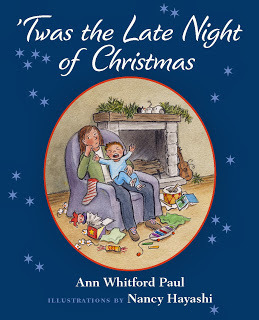
The book began several years ago as a Christmas letter. Instead of writing about our family’s activities, I decided to try something different. What spilled out was my exhaustion about Christmas—exactly like this mother on the cover. Someone had to help and the perfect person, the only one who would appreciate the stress on women, would be another woman—Mrs. Saint Nick. (Read Mrs. Saint Nick's blog here.)The response to the card was so great, I wondered if it could be a book. I approached my dear friend and much published illustrator, Nancy Hayashi. She loved the idea. I love how she envisioned Mrs. Saint Nick.

We’ve gone the self-publishing route, because our book is not easily classified. It’s a picture book for kids and adults, too, especially those who like me find the preparation work both wearying and wearing. It will be available as an e-book and also the old-fashioned page-turning kind. You can find it at your local store or at www.barnesandnoble.com or www.amazon.com Check out the darling YouTube video Jane Kcazmarek (mother of Malcolm in the Middle) made for the book. She also narrates the iTunes Version.

Friends and family call me, “Crazy for Christmas.” They don’t mean it as a compliment.I start decorating for the holiday right after Thanksgiving. Nothing gives me more pleasure than spreading the red and green patchwork quilt over my sofa, placing needlepoint and ribbon pillows on the chairs, hanging cloth gingerbread men from our sconces and Christmas pictures about the walls. I bring out placemats and table runners and even the Christmas China I purchased years ago on sale after one holiday. I love the preparations—the baking, and yes, even the shopping and gift-making. Nothing pleases me more than to set aside my writing and focus on family and friends and what might make them happy. It’s that rare time of the year when we all think more about others than ourselves.Of course, this takes work, and I admit that I’ve been getting tired. Hence this new book ‘TWAS THE LATE NIGHT OF CHRISTMAS

The book began several years ago as a Christmas letter. Instead of writing about our family’s activities, I decided to try something different. What spilled out was my exhaustion about Christmas—exactly like this mother on the cover. Someone had to help and the perfect person, the only one who would appreciate the stress on women, would be another woman—Mrs. Saint Nick. (Read Mrs. Saint Nick's blog here.)The response to the card was so great, I wondered if it could be a book. I approached my dear friend and much published illustrator, Nancy Hayashi. She loved the idea. I love how she envisioned Mrs. Saint Nick.

We’ve gone the self-publishing route, because our book is not easily classified. It’s a picture book for kids and adults, too, especially those who like me find the preparation work both wearying and wearing. It will be available as an e-book and also the old-fashioned page-turning kind. You can find it at your local store or at www.barnesandnoble.com or www.amazon.com Check out the darling YouTube video Jane Kcazmarek (mother of Malcolm in the Middle) made for the book. She also narrates the iTunes Version.
Published on November 29, 2013 05:30
November 28, 2013
From the Office of the Future of Reading
Sometimes our light goes out but is blown into flame by
another human being. Each of us owes deepest thanks to
those who have rekindled this light.
Albert Schweitzer
On this day of Thanksgiving, I am extremely grateful for all of my guest bloggers for The Office of the Future of Reading. I can't tell you how many times my light has gone out in the past year -- dimmed by a bad review, a bad day of writing, bad news.
But then a blog post will show up in my mailbox and I read about another of the millions of ways this country's amazing and dedicated and professional teachers and librarians work to connect kids with books, to build lifelong readers, to build community around literature, and my light is rekindled.
Thank you, thank you, thank you to all of the eighty plus educators who are sharing themselves this year on this blog. Be sure to treat yourself to that second piece of pie.
Published on November 28, 2013 05:30



